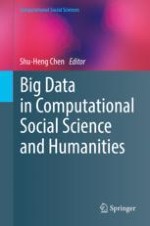
2018 | OriginalPaper | Chapter
1. Big Data in Computational Social Sciences and Humanities: An Introduction
Authors : Shu-Heng Chen, Tina Yu
Published in: Big Data in Computational Social Science and Humanities
Publisher: Springer International Publishing
Activate our intelligent search to find suitable subject content or patents.
Select sections of text to find matching patents with Artificial Intelligence. powered by
Select sections of text to find additional relevant content using AI-assisted search. powered by